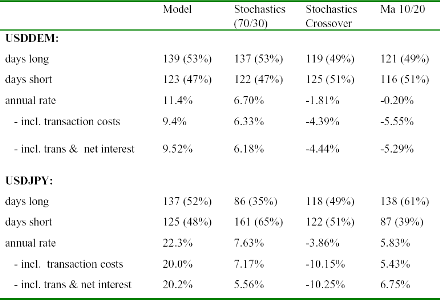The profits from technical analysis are generally compared to a Buy & Hold strategy, where Buy & Hold is considered an investment in a particular currency. The profits of Buy & Hold for USDDEM and USDJPY are calculated as the difference in the exchange rate at the beginning and end of the forecasting period, acknowledging the net interest rate effect of investing in foreign rather than domestic money. As can be seen from Figure 1 and 2, following a Buy & Hold strategy for USDDEM does not result in a substantial profit, in effect the exchange rate increased by only 90 basis points over the sample. Only higher US interest rates left the investor with an annualised return rate of 2.05%.
The appreciation of the dollar against the Yen in the forecasting period from 96.50 Yen to 108.25 Yen per US$ makes Buy & Hold more profitable for USDJPY. The resulting annualised rate of return of 16.25% establishes a difficult test criterion for our technical trading rules. On pure profitability considerations, our model yields by far the highest annualised return rates with 9.52% for USDDEM and 20.20% for USDJPY.
While the Stochastics 70/30 also leaves the investor with a substantial annualised rate of return of 6.18% for USDDEM and 5.56% for USDJPY, the Stochastics Crossover and the Moving Average 10/20 trading model have a pure performance in comparison. While the MA 10/20 fails to provide any profits for USDDEM (-5.29%), it seems, however, to be quite profitable for USDJPY (6.75%). Following the trading signals of the Stochastics Crossover results in effect in a loss for USDDEM (-4.44%) as well as USDJPY (-10.25%).
When the profitability of the different models is compared to a simple Buy&Hold stratgey, the picture changes. While our models have no problem beating Buy&Hold for USDDEM as well as USDJPY, Stochastics 70/30 and MA10/20, that seemed to be doing well for USDJPY on pure profitability considerations both fail to outperform the Buy&Hold benchmark of 16.25%. Taking the returns of Buy&Hold as a measure of the underlying trend rates in the data (Poole, 1967), it can be see that the high excess returns of our models cannot be explained by a positive trend alone.
In fact, the profitability of our models seems to be unrelated to the underlying trend in the currency, since our model yields a high rate of profitability in a trending (as in the case of USDDEM) as well as in trendless (as in the case of USDJPY) markets. The profitability of the trendfollowing MA 10/20 is, however, clearly linked to the underlying trend in the sample. MA10/20 profits in a market with a strong trend (USDJPY) and does appallingly in a trendless market (USDDEM).
Table 8: Profitability Profile of USDDEM and USDJPY trading models

Prof. Ronald MacDonald, Prof. Norbert Fiess
Next: Risk Adjustment
Summary: Index